WWII shipyard magazine illustrator
Lincoln Cushing, 9/28/2021
The World War II home front
demanded huge sacrifices from civilians, and the Kaiser
shipyards saw people from all walks of life working side by
side. My uncle Robert
Heizer was an anthropologist at UC 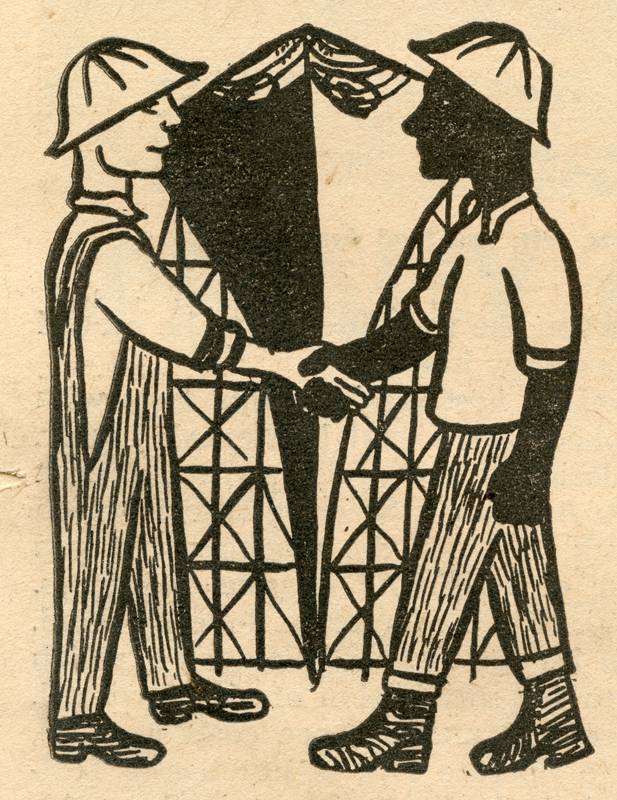 Berkeley
who spent four years as a marine steamfitter in Richmond; he
also wrote for the weekly Kaiser Richmond shipyard magazine Fore
'n' Aft - whose staff editorial assistant was none other
than the well-known contemporary artist Emmy Lou Packard.
Berkeley
who spent four years as a marine steamfitter in Richmond; he
also wrote for the weekly Kaiser Richmond shipyard magazine Fore
'n' Aft - whose staff editorial assistant was none other
than the well-known contemporary artist Emmy Lou Packard.
By the mid-1940s, California native Packard (1914–1998) was already a respected artist in the San Francisco Bay Area. She had received her Bachelor of Arts at UC Berkeley in 1936, where she had been arts editor of the Daily Californian and the campus literary magazine Occident. She was also the first female editor of the humor magazine Pelican. Packard later studied sculpture and fresco painting at the San Francisco Art Institute. She had befriended renowned Mexican artists Diego Rivera and Frida Kahlo, and after her first husband Burton Cairns' tragic death in 1939 Packard went to Mexico where she lived and worked with the artistic couple.
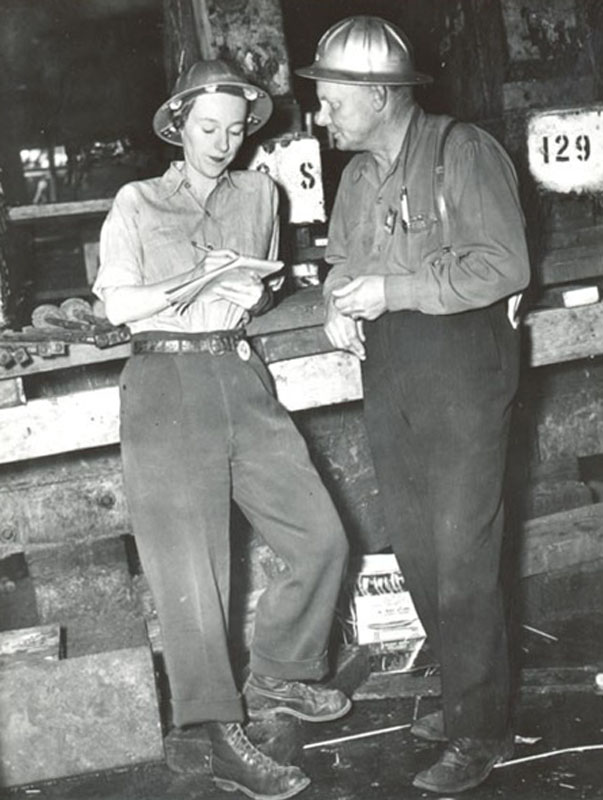
During World War II, Emmy Lou became a draftswoman at the Ames Shipbuilding and Drydock Company office in San Francisco, and later moved across the bay to work in the Kaiser Richmond shipyards. She first appeared in the Fore ‘n’ Aft masthead on June 16, 1944. Soon, in addition to her editorial work, Packard began to contribute art to the newspaper. She created scratchboard illustrations and drawings, drew a recurring single-frame cartoon “Shirley the Whirley” about an anthropomorphic rolling-and-turning shipyard crane with attitude, and collaborated on a cartoon strip called Supermac,” which ran from September 8, 1944, through March 30, 1945.
Her debut as a shipyard illustrator in Fore ‘n’ Aft was July 28, 1944, with a powerful depiction of D-Day, the Allied invasion of Normandy on June 6 that year. Artillery shells bursting in a night sky blasted above the fold, accompanying a first-hand account by former Richmond shipyard worker Richard Cox.
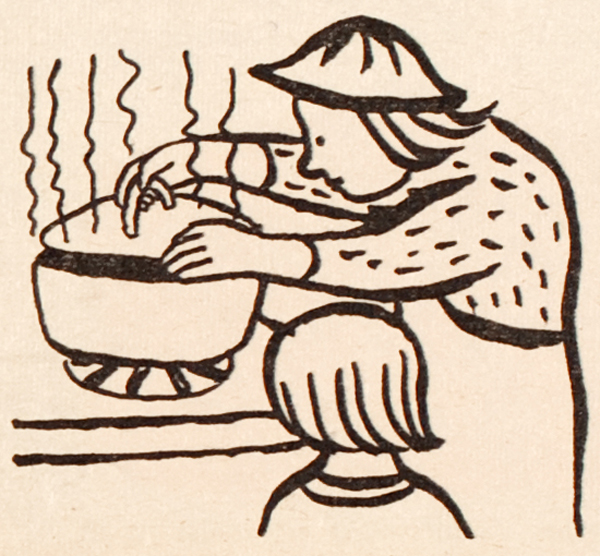 Although she would continue to create a few more major graphics,
her forte became “spot illustrations”— those sweet, tiny images
that break up type-heavy pages. Often, but not always, the
graphics would accompany a specific article such as tips on
workplace safety or healthy eating.
Although she would continue to create a few more major graphics,
her forte became “spot illustrations”— those sweet, tiny images
that break up type-heavy pages. Often, but not always, the
graphics would accompany a specific article such as tips on
workplace safety or healthy eating.
The illustrations were never credited, so identifying those done by Emmy Lou is an inexact process. Her son, Donald Cairns, has helped to try and confirm the approximately 100 illustrations she created over her 15 months at Fore ‘n’ Aft.
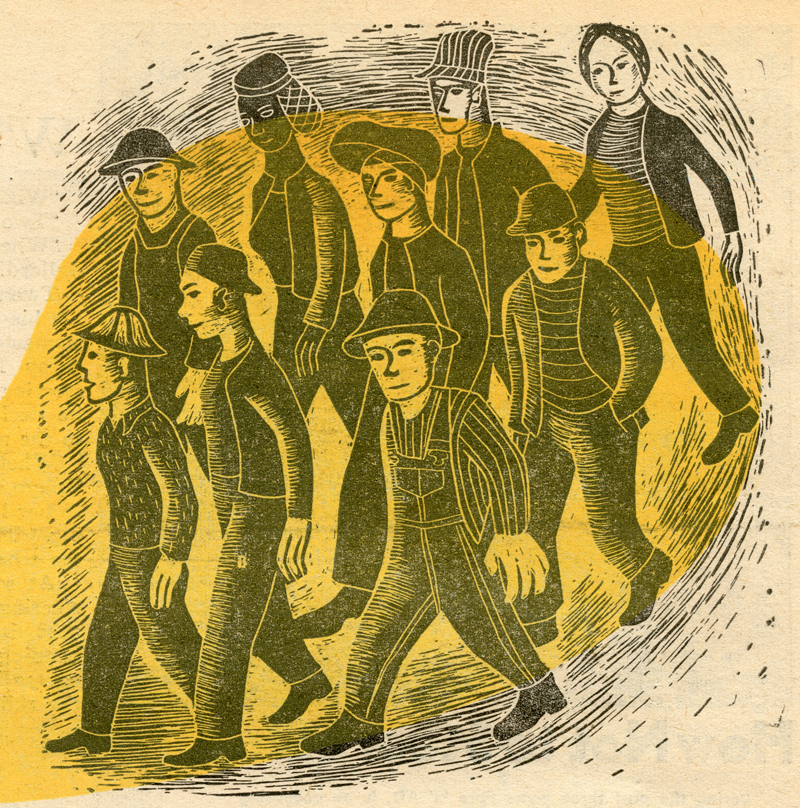
Packard’s lengthy obituary in the San Francisco Chronicle mentioned the approximately 100 paintings she made of shipyard scenes, but said nothing about her work on Fore ‘n’ Aft. Her son’s website honoring Packard’s career briefly mentions that stint without details, but a comprehensive survey of those illustrations did not exist until 2014.
Such an omission can be explained by the unfortunate art world disinterest in something considered as lowly as labor newspaper illustrations as well as lack of access to the source material. The second limitation changed when I directed a partnership between Kaiser Permanente Heritage Resources and the Richmond (California) Museum of History to digitize Fore ‘n’ Aft.
An exhibition on Packard's work was displayed at the Rosie the Riveter WWII Home Front National Park in Richmond in 2015.
What do the illustrations reveal?
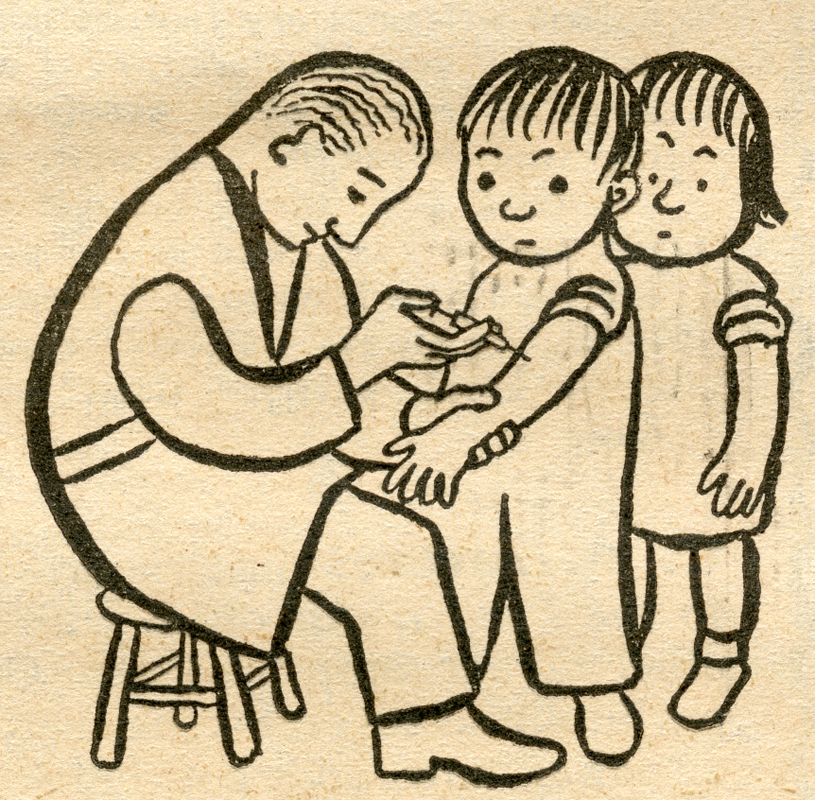 The Kaiser shipyards began making transport vessels for the
British government in 1941, before the United States joined the
war. Two magazines covered seven yards (The Bos'n's Whistle
was the publication for the Portland, Oregon area Kaiser
shipyards), and many of the cartoons and illustrations in the
early issues reflect what one would expect from a trade
dominated by straight, white, male industrial laborers of the
time — sexist, racist, and homophobic.
The Kaiser shipyards began making transport vessels for the
British government in 1941, before the United States joined the
war. Two magazines covered seven yards (The Bos'n's Whistle
was the publication for the Portland, Oregon area Kaiser
shipyards), and many of the cartoons and illustrations in the
early issues reflect what one would expect from a trade
dominated by straight, white, male industrial laborers of the
time — sexist, racist, and homophobic.
But as a vastly different home front workforce replaced them, editorial sensibilities evolved as well. What a difference it made to have a politically progressive woman wielding a pen. Packard’s work was patriotic without resorting to racist jabs or stereotypes; she portrayed workers with dignity and character. She drew women’s experiences from a woman’s point of view — numerous vignettes show children (one of her regular subjects later in life), shopping, home life, and the challenges of survival and adjustment in a tempestuous time.
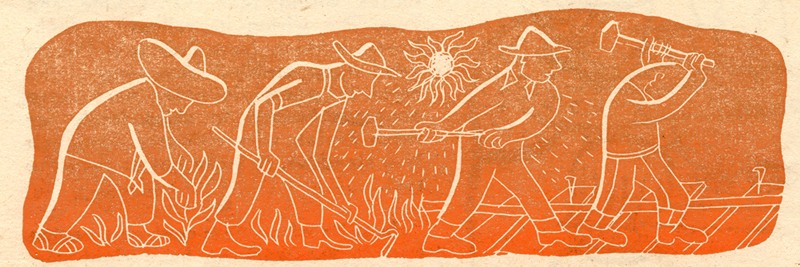 When Packard left Fore ‘n’ Aft, the editors wrote a
testimonial on October 26, 1945 attesting to her contribution:
When Packard left Fore ‘n’ Aft, the editors wrote a
testimonial on October 26, 1945 attesting to her contribution:
“Emmy Lou Packard is a fine artist. She painted the people who work in the yards with a deftness and freshness. But more, she sketched and painted how these workers feel. She pictured man in the complicated throes of the huge shipyards, with twisting pipes and rolls of cable drums, boilers and ten-ton steel plates, and plate shop presses fifteen feet high. Always man was a part of this complexity and always he controlled the huge machines and materials.”
These are but a few examples of Emmy Lou Packard’s previously unexamined yet important work.
See Richmond Confidential and Eichler Network articles on exhibition at the Rosie the Riveter WWII Home Front National Historical Park
 Berkeley
who spent four years as a marine steamfitter in Richmond; he
also wrote for the weekly Kaiser Richmond shipyard magazine Fore
'n' Aft - whose staff editorial assistant was none other
than the well-known contemporary artist Emmy Lou Packard.
Berkeley
who spent four years as a marine steamfitter in Richmond; he
also wrote for the weekly Kaiser Richmond shipyard magazine Fore
'n' Aft - whose staff editorial assistant was none other
than the well-known contemporary artist Emmy Lou Packard.By the mid-1940s, California native Packard (1914–1998) was already a respected artist in the San Francisco Bay Area. She had received her Bachelor of Arts at UC Berkeley in 1936, where she had been arts editor of the Daily Californian and the campus literary magazine Occident. She was also the first female editor of the humor magazine Pelican. Packard later studied sculpture and fresco painting at the San Francisco Art Institute. She had befriended renowned Mexican artists Diego Rivera and Frida Kahlo, and after her first husband Burton Cairns' tragic death in 1939 Packard went to Mexico where she lived and worked with the artistic couple.

During World War II, Emmy Lou became a draftswoman at the Ames Shipbuilding and Drydock Company office in San Francisco, and later moved across the bay to work in the Kaiser Richmond shipyards. She first appeared in the Fore ‘n’ Aft masthead on June 16, 1944. Soon, in addition to her editorial work, Packard began to contribute art to the newspaper. She created scratchboard illustrations and drawings, drew a recurring single-frame cartoon “Shirley the Whirley” about an anthropomorphic rolling-and-turning shipyard crane with attitude, and collaborated on a cartoon strip called Supermac,” which ran from September 8, 1944, through March 30, 1945.
Her debut as a shipyard illustrator in Fore ‘n’ Aft was July 28, 1944, with a powerful depiction of D-Day, the Allied invasion of Normandy on June 6 that year. Artillery shells bursting in a night sky blasted above the fold, accompanying a first-hand account by former Richmond shipyard worker Richard Cox.
 Although she would continue to create a few more major graphics,
her forte became “spot illustrations”— those sweet, tiny images
that break up type-heavy pages. Often, but not always, the
graphics would accompany a specific article such as tips on
workplace safety or healthy eating.
Although she would continue to create a few more major graphics,
her forte became “spot illustrations”— those sweet, tiny images
that break up type-heavy pages. Often, but not always, the
graphics would accompany a specific article such as tips on
workplace safety or healthy eating.The illustrations were never credited, so identifying those done by Emmy Lou is an inexact process. Her son, Donald Cairns, has helped to try and confirm the approximately 100 illustrations she created over her 15 months at Fore ‘n’ Aft.

Packard’s lengthy obituary in the San Francisco Chronicle mentioned the approximately 100 paintings she made of shipyard scenes, but said nothing about her work on Fore ‘n’ Aft. Her son’s website honoring Packard’s career briefly mentions that stint without details, but a comprehensive survey of those illustrations did not exist until 2014.
Such an omission can be explained by the unfortunate art world disinterest in something considered as lowly as labor newspaper illustrations as well as lack of access to the source material. The second limitation changed when I directed a partnership between Kaiser Permanente Heritage Resources and the Richmond (California) Museum of History to digitize Fore ‘n’ Aft.
An exhibition on Packard's work was displayed at the Rosie the Riveter WWII Home Front National Park in Richmond in 2015.
What do the illustrations reveal?
 The Kaiser shipyards began making transport vessels for the
British government in 1941, before the United States joined the
war. Two magazines covered seven yards (The Bos'n's Whistle
was the publication for the Portland, Oregon area Kaiser
shipyards), and many of the cartoons and illustrations in the
early issues reflect what one would expect from a trade
dominated by straight, white, male industrial laborers of the
time — sexist, racist, and homophobic.
The Kaiser shipyards began making transport vessels for the
British government in 1941, before the United States joined the
war. Two magazines covered seven yards (The Bos'n's Whistle
was the publication for the Portland, Oregon area Kaiser
shipyards), and many of the cartoons and illustrations in the
early issues reflect what one would expect from a trade
dominated by straight, white, male industrial laborers of the
time — sexist, racist, and homophobic.But as a vastly different home front workforce replaced them, editorial sensibilities evolved as well. What a difference it made to have a politically progressive woman wielding a pen. Packard’s work was patriotic without resorting to racist jabs or stereotypes; she portrayed workers with dignity and character. She drew women’s experiences from a woman’s point of view — numerous vignettes show children (one of her regular subjects later in life), shopping, home life, and the challenges of survival and adjustment in a tempestuous time.
 When Packard left Fore ‘n’ Aft, the editors wrote a
testimonial on October 26, 1945 attesting to her contribution:
When Packard left Fore ‘n’ Aft, the editors wrote a
testimonial on October 26, 1945 attesting to her contribution:“Emmy Lou Packard is a fine artist. She painted the people who work in the yards with a deftness and freshness. But more, she sketched and painted how these workers feel. She pictured man in the complicated throes of the huge shipyards, with twisting pipes and rolls of cable drums, boilers and ten-ton steel plates, and plate shop presses fifteen feet high. Always man was a part of this complexity and always he controlled the huge machines and materials.”
These are but a few examples of Emmy Lou Packard’s previously unexamined yet important work.
See Richmond Confidential and Eichler Network articles on exhibition at the Rosie the Riveter WWII Home Front National Historical Park
2022 exhibition at Richmond Art
Center, 48 Hills article "Artist Emmy Lou Packard shines in overdue expo—but she never left SF
walls"
https://48hills.org/2022/08/artist-emmy-lou-packard-shines-in-overdue-expo-but-she-never-left-sf-walls/
[This article was originally
published through Kaiser Permanente Heritage Resources 9/3/2014;
later "de-published"]
Images:
Photo: http://www.museumca.org/picturethis/pictures/emmy-lou-packard-talking-unknown-man-richmond-shipyards
“Emmy Lou Packard talking to an unknown man at the Richmond shipyards. circa 1941–1945. Photographer unknown. Gelatin silver print. Collection of Oakland Museum of California. The Oakland Tribune Collection. Gift of Emmy Lou Packard.”
ELP 1945-02-22-1
For many, the shipyards was the first experience in working alongside people of different races; here, black-white cooperation is graphically reinforced by the positive and negative shadowing of the ship they have built together behind them.
ELP 1945-03-30-2
This hard-hat-wearing dinner-making mother succinctly shows women’s nonstop work at home and in shipyard production.
ELP 1945-03-09-1
The pageant of around-the-clock workers arriving and departing from the yards was captured in this vignette.
ELP 1945-01-26-4
The wartime Kaiser shipyards offered extensive child care facilities and family health care.
ELP 1945-03-30-1
Many Fore ‘n’ Aft articles featured the rich diversity of the labor force; this illustration about Latin American immigrant workers is beautifully rendered by Packard in a style that would have made Diego Rivera proud.
Return to Docs Populi - Documents for the Public
Updated 3/4/2023
Images:
Photo: http://www.museumca.org/picturethis/pictures/emmy-lou-packard-talking-unknown-man-richmond-shipyards
“Emmy Lou Packard talking to an unknown man at the Richmond shipyards. circa 1941–1945. Photographer unknown. Gelatin silver print. Collection of Oakland Museum of California. The Oakland Tribune Collection. Gift of Emmy Lou Packard.”
ELP 1945-02-22-1
For many, the shipyards was the first experience in working alongside people of different races; here, black-white cooperation is graphically reinforced by the positive and negative shadowing of the ship they have built together behind them.
ELP 1945-03-30-2
This hard-hat-wearing dinner-making mother succinctly shows women’s nonstop work at home and in shipyard production.
ELP 1945-03-09-1
The pageant of around-the-clock workers arriving and departing from the yards was captured in this vignette.
ELP 1945-01-26-4
The wartime Kaiser shipyards offered extensive child care facilities and family health care.
ELP 1945-03-30-1
Many Fore ‘n’ Aft articles featured the rich diversity of the labor force; this illustration about Latin American immigrant workers is beautifully rendered by Packard in a style that would have made Diego Rivera proud.
Return to Docs Populi - Documents for the Public
Updated 3/4/2023